Enzymes(酶)
Enzymes are very efficient and specific catalyst proteins which react with 1 or few types of substrates in biochemical reactions and are responsible for bringing about almost all of the chemical reactions in living organisms. Enzymes speed up reactions by providing an alternative reaction pathway of lower activation energy. Without enzymes, reactions take place at a rate far too slow for the pace of metabolism which means that they speed up the chemical reactions in living things.
There are 2 types of enzymes, ones that help join specific molecules together to form new molecules & others that help break specific molecules apart into separate molecules. Enzymes play many important roles ouside the cell as well. One of the best examples of this is the digestive system. For instance, it is enzymes in your digestive system that break food down in your digestive system break food down into small molecules that can be absorbed by the body. Some enzymes in your digestive system break down starch, some proteins and others break down fats. The enzymes used to digest our food are extra-cellular since they are located outside our cells & enzymes inside our cells are intra-cellular enzymes. Enzymes are used in ALL chemical reactions in living things; this includes respiration, photosynthesis, movement growth, getting rid of toxic chemicals in the liver and so on. Enzymes are proteins that must have the correct structure to be active. They are very easily affected by heat, pH and heavy metal ions.
Ribonucleoprotein enzyme catalytic activity is located in the protein part but for some the catalytic activity is in the RNA part. A catalyst is any substance which makes a chemical reaction go faster, without itself being changed. A catalyst can be used over and over again in a chemical reaction and does not get used up.
Enzymes lower the amount of activation energy needed by binding to the reactants of the reaction they catalyze, thus speed up the reaction and can process millions of molecules per second. Enzymes are typically large proteins with high molecular weight that permit reactions to go at conditions that the body can tolerate.
Enzyme nomenclature is based on what the enzyme reacts with & how it reacts along with the ending ase.
Enzymes must get over the activation energy hurdle.
Enzymes change how a reaction will proceed which reduces the activation energy and makes it faster. The more we increase the enzyme concentration the faster the reaction rate for non-catalyzed reactions. Enzymes that are catalyzed reactions also increase reaction rate at higher level of concentration but up to a certain point called Vmax which means that the enzyme has reached its maximum point. The reaction is limited by both the concentrations of the enzyme and substrate. Enzymes as catalysts take part in reactions which provide an alternative reaction pathway. Enzymes do not undergo permanent changes and remain unchanged at the end of the reaction. They only change the rate of reaction, not the position of the equilibrium.Enzymes as catalysts are highly selective by only catalysing specific reactions due to the shapes of the enzyme’s molecule.
Enzymes contain a globular protein part called apoenzyme and a non-protein part named cofactor or prosthetic group or metal-ion-activator. Changes in temperature and pH have great influence on the intra- and intermolecular bonds that hold the protein part in their secondary and tertiary structures.
Examples of cofactors are 1. Prosthetic group that are permanently bound to the enzyme. 2. Activator group which are cations (positively charged metal ions) & temporarily bind to the active site of the enzyme. 3.Coenzymes, usually vitamins or made from vitamins which are not permanently bound to the enzyme molecule, but combine with the enzyme-substrate complex temporarily. Enzymes require the presence cofactors before their catalytic activity can be exerted. This entire active complex is referred to as the holoenzyme.
Without enzymes, our guts would take weeks to digest our food, our muscles, nerves and bones would not work properly and so on…
Main Enzyme category groups:
Oxidoreductases:
All enzymes that catalyse oxido-reductions belong in this class. The substrate oxidized is regarded as a hydrogen or electron donor. The classification is based on 'donor:acceptor oxidoreductase'. The common name is 'dehydrogenase', wherever this is possible; as an alternative, 'acceptor reductase' can be used. 'Oxidase' is used only where O2 is an acceptor. Classification is difficult in some cases, because of the lack of specificity towards the acceptor.
Transferases:
Transferases are enzymes that transfer a group, for example, the methyl group or a glycosyl group, from one compound (generally regarded as donor) to another compound (generally regarded as acceptor). The classification is based on the scheme 'donor:acceptor grouptransferase'. The common names are normally formed as 'acceptor grouptransferase' or 'donor grouptransferase'. In many cases, the donor is a cofactor (coenzyme) that carries the group to be transferred. The aminotransferases constitute a special case.
Hydrolases:
These enzymes catalyse the hydrolysis of various bonds. Some of these enzymes pose problems because they have a very wide specificity, and it is not easy to decide if two preparations described by different authors are the same, or if they should be listed under different entries. While the systematic name always includes 'hydrolase', the common name is, in most cases, formed by the name of the substrate with the suffix -ase. It is understood that the name of the substrate with this suffix, and no other indicator, means a hydrolytic enzyme. It should be noted that peptidases have recommended names rather than common names.
Lyases:
Lyases are enzymes that cleave C-C, C-O, C-N and other bonds by means other than by hydrolysis or oxidation. They differ from other enzymes in that two (or more) substrates are involved in one reaction direction, but there is one compound fewer in the other direction. When acting on the single substrate, a molecule is eliminated and this generates either a new double bond or a new ring. The systematic name is formed according to 'substrate group-lyase'. In common names, expressions like decarboxylase, aldolase, etc. are used. 'Dehydratase' is used for those enzymes that eliminate water. In cases where the reverse reaction is the more important, or the only one to be demonstrated, 'synthase' may be used in the name.
Ligases:
Ligases are enzymes that catalyse the joining of two molecules with concomitant hydrolysis of the diphosphate bond in ATP or a similar triphosphate. 'Ligase' is often used for the common name, but, in a few cases, 'synthase' or 'carboxylase' is used. 'Synthetase' may be used in place of 'synthase' for enzymes in this class.
Products for Enzymes
- 41701(11)
- Activating Transcription Factor(3)
- Adenylate Kinase(10)
- AHCY(3)
- Aldolase(9)
- Asparaginase(5)
- Aurora Kinase(18)
- Beta Lactamase(3)
- Calcium and Integrin Binding(2)
- Calcium/Calmodulin-Dependent Protein Kinase(4)
- Carbonic Anhydrase(49)
- Casein Kinase(36)
- Cathepsin(52)
- Chitinase(5)
- Creatin Kinases(9)
- Cyclin(7)
- Cyclin-Dependent Kinase(18)
- Cyclophilin(23)
- Deaminase(14)
- Decarboxylase(12)
- Dehydrogenase(96)
- Discoidin Domain Receptor Tyrosine Kinase(2)
- DNA Polymerase(4)
- EGF Receptor(3)
- Endonuclease(6)
- Enolase(10)
- Enterokinase(5)
- Epimerase(3)
- Esterase(15)
- FGF Receptors(12)
- FK506 Binding Protein(10)
- Fructosamine 3 Kinase(2)
- Galactosidase(5)
- Glucosidase(32)
- Gluteradoxin(7)
- Glycogen synthase kinase(2)
- Glycosylase(10)
- Glyoxalase(3)
- Granzyme(7)
- Guanylate Kinase(2)
- Heparanase(2)
- Histone Deacetylase(3)
- Hydratase(10)
- Hydrolase(33)
- Hydroxylase(6)
- Isomerase(26)
- Jun N-terminal Kinase(1)
- Jun Proto-Oncogene(2)
- Kallikrein(26)
- Ligase(4)
- Lipase(14)
- Lipocalin(6)
- Lyase(9)
- LYVE1(3)
- Mitogen-Activated Protein Kinase(16)
- MMP(68)
- Mutase(11)
- Natural Enzymes(4)
- Nuclease(18)
- Nucleotidase(4)
- Nudix Type Motif(11)
- Other Enzymes(63)
- Oxidase(23)
- Oxygenase(12)
- Paraoxonase(3)
- Peptidase(41)
- Peroxiredoxin(10)
- Phosphatase(150)
- Phosphorylase(9)
- PI3-kinase(5)
- Polymerase(13)
- PPARG(2)
- Protease(15)
- Proteasome(54)
- Protein Kinase Akt1/PKB alpha(4)
- Protein Kinase-A(7)
- Protein Kinase-C(3)
- Protein Kinases(86)
- Protein Tyrosine Phosphatase(10)
- Reductase(60)
- Secreted Phospholipase A2(10)
- Serine Threonine Kinase(4)
- Sulfatase(8)
- Synthase(23)
- Synthetase(33)
- TGFBR(3)
- TGM2(3)
- TIMP(10)
- TPA(4)
- Transferase(156)
- Tyrosine Kinase(9)
- Ubiquitin Conjugating Enzyme(39)
- Uromodulin(4)
- VEGF Receptors(14)
- Transaminase(19)
- Hexokinase(6)
- TIE1(6)
- Cat.No. 产品名称 Information
-
GP22196
PTGES3 Human
Prostaglandin E Synthase 3 Human Recombinant

-
GP22197
PTGR1 Human
Prostaglandin Reductase 1 Human Recombinant

-
GP22198
PTGR2 Human
Prostaglandin Reductase 2 Human Recombinant

-
GC64556
PTP1B-IN-15
PTP1B-IN-15 是一种有效的选择性蛋白酪氨酸磷酸酶 1B (PTP1B) 抑制剂。PTP1B-IN-15具有研究II型糖尿病和肥胖症的潜力。
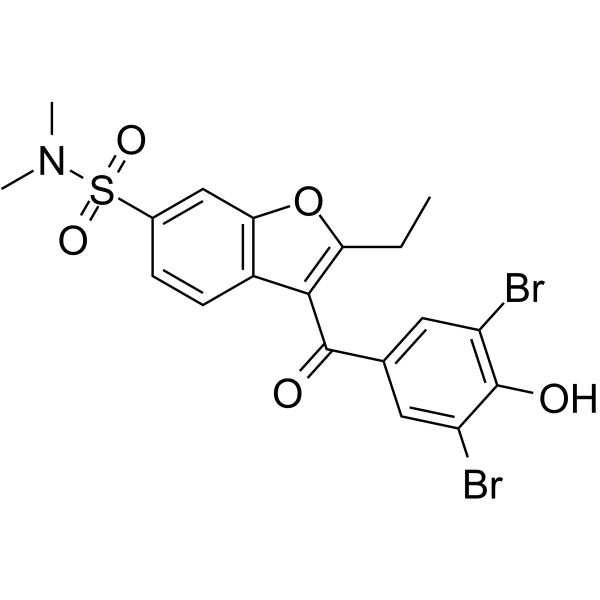
-
GC63705
PTP1B-IN-3 diammonium
PTP1B-IN-3 diammonium 是有效的,有选择性的 PTP1B 抑制剂,对 PTP1B 和 TCPTP 的 IC50 值均为 120 nM。PTP1B-IN-3 diammonium 具有抗糖尿病和抗癌作用。
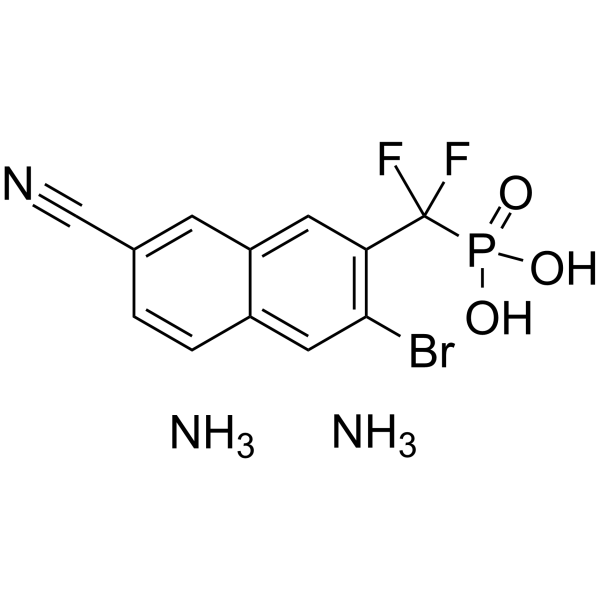
-
GC61221
PTP1B-IN-9
NSC 638643
An inhibitor of the ubiquitin-proteasome system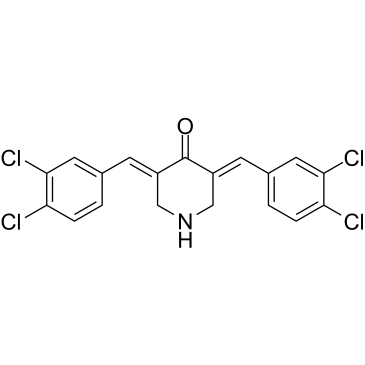
-
GP22199
PTP4A1 Human
Protein Tyrosine Phosphatase Type IVA Member 1 Human Recombinant

-
GP22200
PTP4A2 Human
Protein Tyrosine Phosphatase Type IVA Member 2 Human Recombinant

-
GP22201
PTP4A3 Human
Protein Tyrosine Phosphatase Type IVA Member 3 Human Recombinant

-
GP22202
PTPMT1 Human
Protein Tyrosine Phosphatase, Mitochondrial 1 Human Recombinant

-
GP22617
PTPN1 Human
Protein Tyrosine Phosphatase Non Receptor Type-1 Human Recombinant

-
GP22621
PTPN11 Human
Protein Tyrosine Phosphatase Non Receptor Type-11 Human Recombinant

-
GP26196
PTPN11 Human, Active
PTPN11 Human produced in Sf9 Insect cells is a single, glycosylated polypeptide chain containing 602 amino acids ( 1-593 a

-
GC73467
PTPN2/1-IN-2
PTPN2/1-IN-2是一种PTPN2/1拮抗剂,可用于各种肿瘤研究。
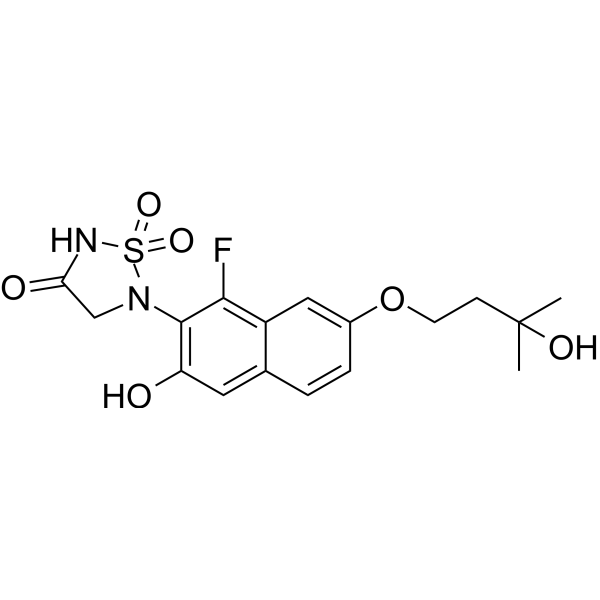
-
GP22618
PTPN4 Human
Protein Tyrosine Phosphatase Non Receptor Type-4 Human Recombinant

-
GP22619
PTPN6 Human
Protein Tyrosine Phosphatase Non Receptor Type-6 Human Recombinant

-
GP22620
PTPN7 Human
Protein Tyrosine Phosphatase Non Receptor Type-7 Human Recombinant

-
GP22203
PTPRC Human
Protein Tyrosine Phosphatase Receptor Type C Human Recombinant

-
GP26176
PTPRN Human
Recombinant Human Protein Tyrosine Phosphatase Receptor Type N produced in SF9 is a glycosylated, polypeptide chain having a calculated molecular mass of 46kDa

-
GP22204
PTPS Human
6-Pyruvoyltetrahydropterin Synthase Human Recombinant

-
GP22205
PTRH2 Human
Peptidyl-tRNA Hydrolase 2 Human Recombinant

-
GP22206
PTRHD1 Human
Peptidyl-TRNA Hydrolase Domain Containing 1 Human Recombinant

-
GP22207
PYCR1 Human
Pyrroline-5-Carboxylate Reductase 1 Human Recombinant

-
GP22208
PYCR2 Human
Pyrroline-5-Carboxylate Reductase 2 Human Recombinant

-
GP22209
PYCRL Human
Pyrroline-5-Carboxylate Reductase Like Human Recombinant

-
GP22210
PYGL Human
Phosphorylase, Glycogen, Liver Human Recombinant

-
GP22622
pykF E.Coli
Pyruvate Kinase I E.Coli Recombinant

-
GP22211
QDPR Human
醌型二氢蝶啶还原酶人重组体

-
GP22212
QPCT Human
Glutaminyl-Peptide Cyclotransferase Human Recombinant

-
GP22213
QPRT Human
Quinolinate Phosphoribosyltransferase Human Recombinant

-
GP22214
QTRT1 Human
Queuine TRNA-Ribosyltransferase 1 Human Recombinant

-
GP22215
QTRTD1 Human
Queuine TRNA-Ribosyltransferase Domain Containing 1 Human Recombinant

-
GC62399
RA375
RA375 是 RPN13 (26S 蛋白酶体亚基) 抑制剂。RA375 激活 UPR 信号、ROS 产生和凋亡。RA375 的抗肿瘤活性是 RA190的 10 倍。

-
GC62687
Razuprotafib
AKB-9778
Razuprotafib (AKB-9778) 是 VE-PTP (HPTPß) 催化活性的有效选择性抑制剂 (IC50=17 pM),促进 TIE2 活化,增强 ANG1 诱导的 TIE2 活化,并刺激 TIE2 通路中信号分子的磷酸化,包括 AKT、eNOS 和 ERK。Razuprotafib 抑制结构相关磷酸酶 PTP1B,IC50 为 780 nM。除 HPTPΗ (IC50=36 pM) 和 HPTPγ (100 pM) 外,Razuprotafib 对 VE-PTP 具有良好的选择性。
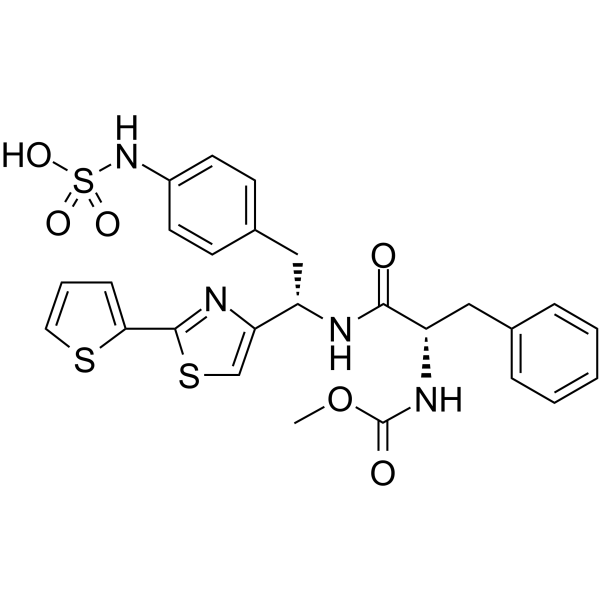
-
GP22623
RBKS Human
Ribokinase Human Recombinant

-
GP22216
RDH12 Human
Retinol Dehydrogenase 12 Human Recombinant

-
GC63856
Relacatib
SB-462795
Relacatib (SB-462795) 是一种新的,有效的口服活性的人组织蛋白酶 K, L 和 V (cathepsins K, L, V) 的抑制剂,其Ki 值分别为 41, 68 和 53 pM。Relacatib 原位抑制人破骨细胞内源性组织蛋白酶 K 和人破骨细胞介导的骨吸收,IC50 值分别为 45 nM 和 70 nM。Relacatib 对体外人体组织骨吸收的抑制作用,以及对食蟹猴体内骨吸收有抑制作用。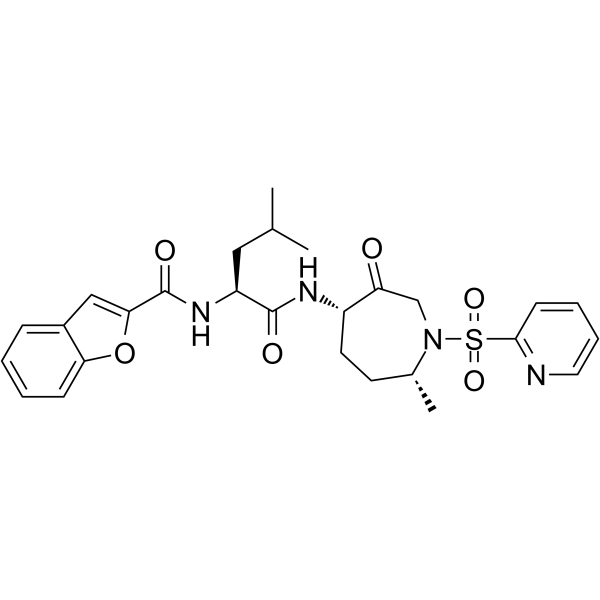
-
GC61242
Resveratroloside
白藜芦醇-4'-O-葡萄糖苷,trans-Resveratrol 4'-O-β-D-glucopyranoside
Resveratroloside是一种α-glucosidase的竞争新抑制剂,能调节血糖水平。Resveratroloside具有心脏保护作用。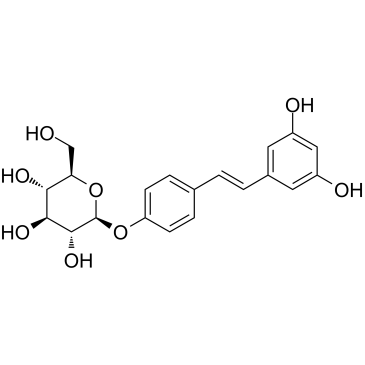
-
GP22217
REV1 Human
REV1 Polymerase Human Recombinant

-
GP22218
REXO1 Human
RNA Exonuclease 1 Human Recombinant

-
GP22219
REXO2 Human
RNA Exonuclease 2 Human Recombinant

-
GP22220
Rhodanese Human
Thiosulfate Sulfurtransferase Human Recombinant

-
GC63487
RMC-4630
SHP2-IN-7
RMC-4630 (SHP2-IN-7) 是 一种 SHP2 抑制剂,来自专利 WO2018013597。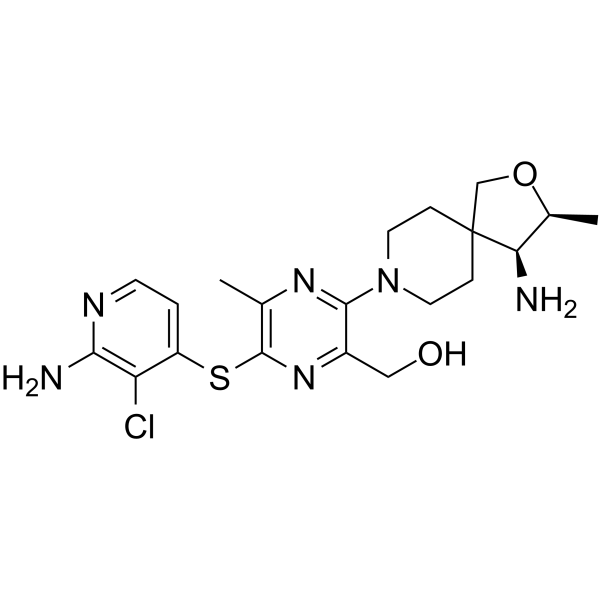
-
GP26177
RNASE1 Human
RNASE1 Human Recombinant produced in HEK cells is a single, glycosylated, polypeptide chain (29-156 a

-
GP26178
RNASE2 Human
RNASE2 Human produced in Sf9 Baculovirus cells is a single, glycosylated polypeptide chain containing 143 amino acids (28-161 a

-
GP22221
RNASE3 Human
Ribonuclease 3 Human Recombinant

-
GP22222
RNASE3 Human, Sf9
Ribonuclease 3 Human Recombinant, Sf9

-
GP22225
RNASE7 Human
Ribonuclease 7 Human Recombinant

-
GP22223
RNASEH1 E.Coli
Ribonuclease H1 E.Coli Recombinant

-
GP22224
RNASEH2A E.Coli
Ribonuclease H2A E.Coli Recombinant





